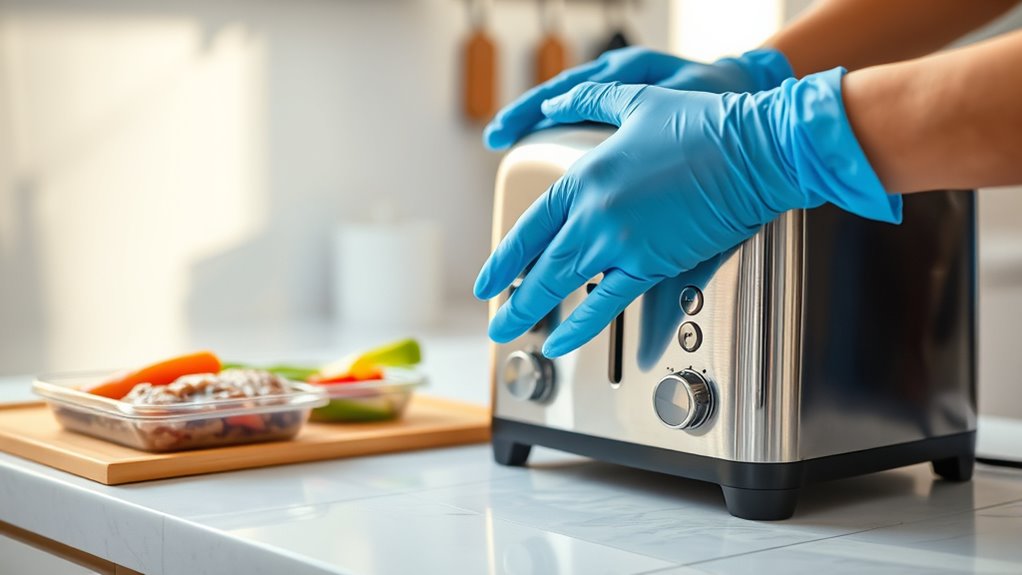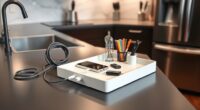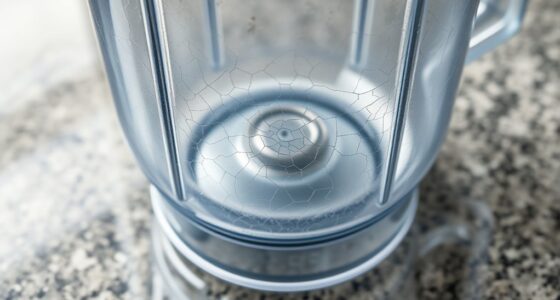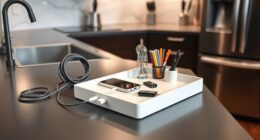To prevent cross-contamination with small appliances, you should clean all removable parts thoroughly after every use with hot, soapy water or dishwasher cycles. Store equipment in a clean, dry place and keep raw food attachments separate from ready-to-eat ones. Regularly check for damage and replace worn parts to maintain safety. Properly organizing, cleaning, and maintenance are key — keep going to discover more ways to keep your food safe and your appliances hygienic.
Key Takeaways
- Wash all removable parts thoroughly after each use to eliminate bacteria and food residues.
- Store appliance components separately to prevent cross-contact between raw and ready-to-eat foods.
- Regularly inspect and replace damaged parts to avoid contamination risks.
- Use dedicated attachments for raw ingredients and different ones for cooked or ready-to-eat items.
- Clean blades and crevices meticulously to prevent trapped food and bacterial growth.
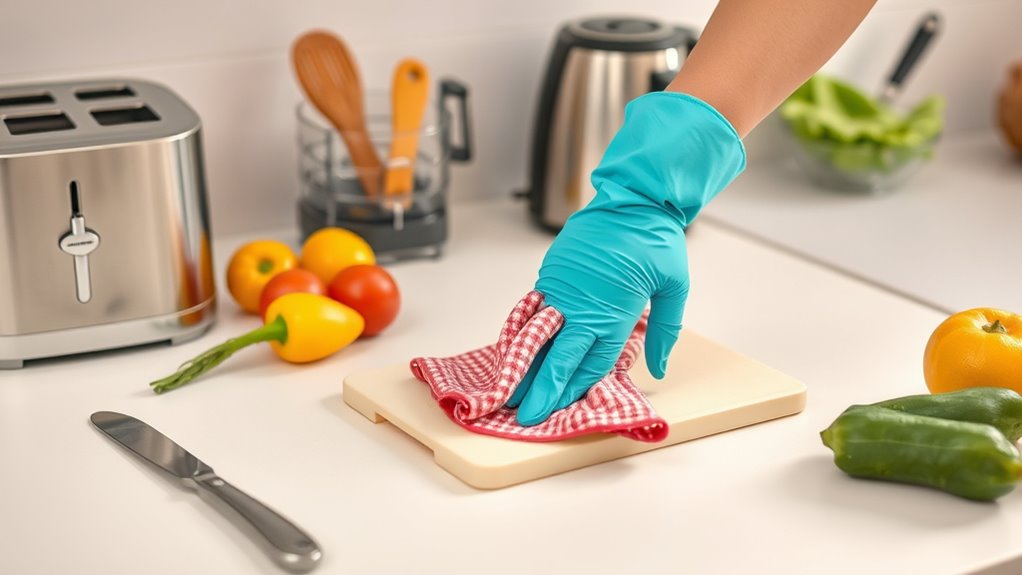
Small appliances like blenders, toasters, and food processors make cooking easier, but they also require proper care to guarantee food safety. One of the most important steps is establishing effective cleaning routines. After each use, you should thoroughly wash all removable parts with hot, soapy water, ensuring you remove any food residue or bacteria that could cause cross-contamination. Pay special attention to blades and crevices where food can get trapped. For appliances with dishwasher-safe components, running them through a cycle can save time and ensure thorough sanitation. Remember to dry all parts completely before storing or reassembling, as lingering moisture can promote mold growth and bacterial development.
In addition to cleaning routines, proper storage tips play a crucial role in maintaining food safety. Once your small appliance parts are dry, store them in a clean, dry place, ideally in a designated cabinet away from raw meats or other contaminating foods. Keeping the components organized prevents accidental cross-contact with raw ingredients or unclean surfaces. Avoid stacking appliances or parts haphazardly, as this can lead to damage or contamination. If your appliance has a storage case or container, use it to keep parts protected from dust and pests. Be cautious about storing attachments that come into contact with raw foods near those used for ready-to-eat items, to prevent bacteria transfer.
When it comes to your appliance’s overall care, remember that proper cleaning routines and storage tips go hand in hand. Regularly inspect your appliances for any signs of wear or damage, which could harbor bacteria or compromise safety. For instance, cracked blades or broken seals should be replaced promptly. Always unplug the device before cleaning or handling parts, and avoid submerging electrical components in water. If you notice any lingering odors or stains despite cleaning, consider sanitizing with a vinegar solution or specialized cleaner to eliminate bacteria and prevent cross-contamination. Additionally, advancements in automation technology are improving how small appliances can assist in maintaining hygiene, making it easier to keep your kitchen safe. Proper maintenance not only extends the lifespan of your appliances but also safeguards your health by preventing the spread of harmful bacteria.
Frequently Asked Questions
How Often Should I Disinfect My Small Appliances?
You should disinfect your small appliances after each use, especially if they come into contact with raw food or juices. Regular appliance maintenance includes wiping down surfaces with a disinfectant to prevent bacteria buildup. The disinfectant frequency depends on how often you use the appliance and what you use it for, but a good rule is to disinfect after every use or at least once a day if used frequently.
Can I Use the Same Cutting Board for Raw and Cooked Foods?
Using the same cutting board for raw and cooked foods is like mixing paint colors—you risk contaminating your cooked foods with dangerous bacteria. For proper cutting board hygiene, always use separate boards for raw meats and cooked meals. This simple separation ensures raw-cooked separation, reducing cross-contamination. Keep your kitchen safe by dedicating different boards or thoroughly cleaning and disinfecting after handling raw ingredients before preparing cooked foods.
What Are the Best Cleaning Agents for Small Appliance Surfaces?
You should use food-grade disinfectants or appliance surface cleaners to effectively sanitize your small appliances. These cleaning agents are safe for food contact surfaces and help eliminate bacteria and viruses. Always follow the manufacturer’s instructions for proper use. Regularly clean and disinfect appliances like blenders, toasters, and coffee makers to prevent cross-contamination. Proper cleaning guarantees your appliances stay safe and hygienic, protecting you and your family from potential foodborne illnesses.
Are There Specific Storage Tips to Prevent Cross-Contamination?
To prevent cross-contamination, you should practice proper storage and separation techniques. Store raw meats separately from ready-to-eat foods, ideally in sealed containers on the bottom shelves of your refrigerator. Keep small appliances clean and dry, and avoid placing cooked foods near raw ingredients. Using designated storage areas for different food types minimizes cross-contact, ensuring your kitchen remains safe and hygienic. Always double-check that storage areas are organized and properly labeled.
How Do I Prevent Mold Growth in Small Appliances?
To prevent mold growth in small appliances, you should regularly clean all parts, including cleaning brushes, with hot, soapy water. Make sure to dry thoroughly, focusing on moisture control—wipe down surfaces and leave appliances open to air out. Store them in a cool, dry place. These steps help eliminate excess moisture, preventing mold spores from thriving and keeping your appliances safe and clean.
Conclusion
Remember, cleanliness is next to godliness when it comes to small appliances. Always wash and sanitize your tools after each use to prevent cross-contamination. Keep your appliances dry, and store them properly. As the saying goes, “A stitch in time saves nine.” Taking a few moments now to care for your appliances can save you from bigger food safety issues later. Stay vigilant, and enjoy safe, delicious meals every time!
